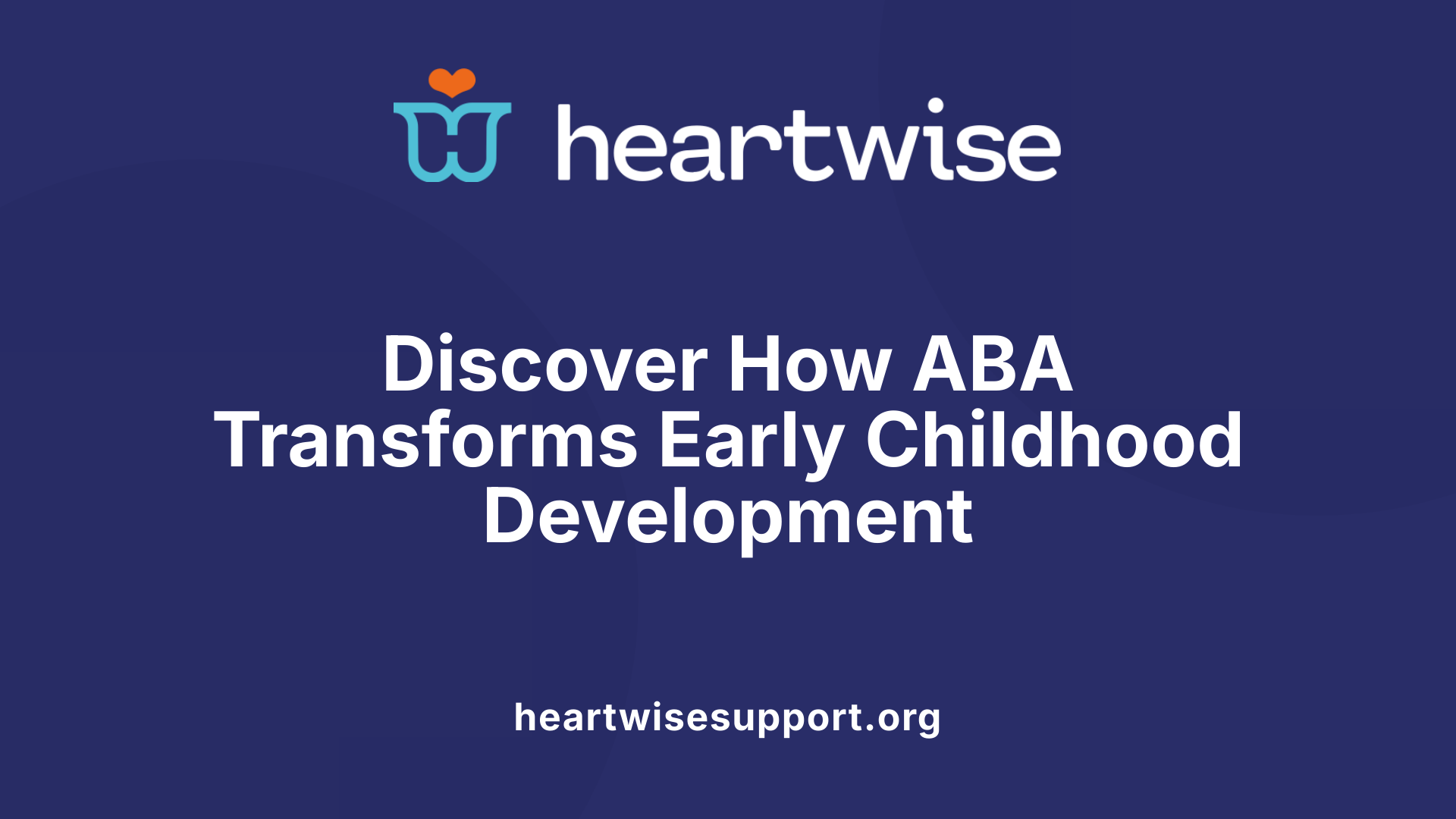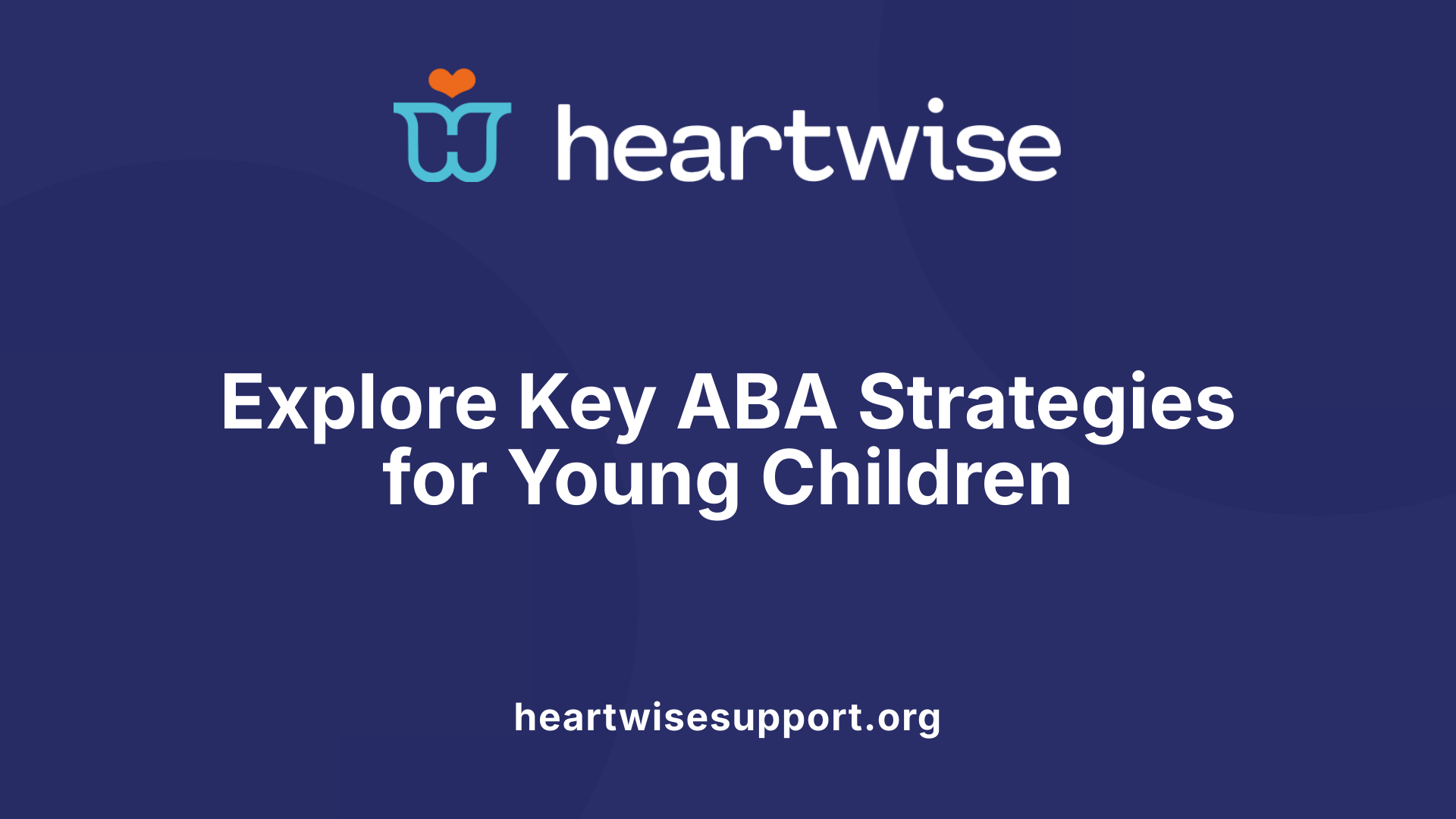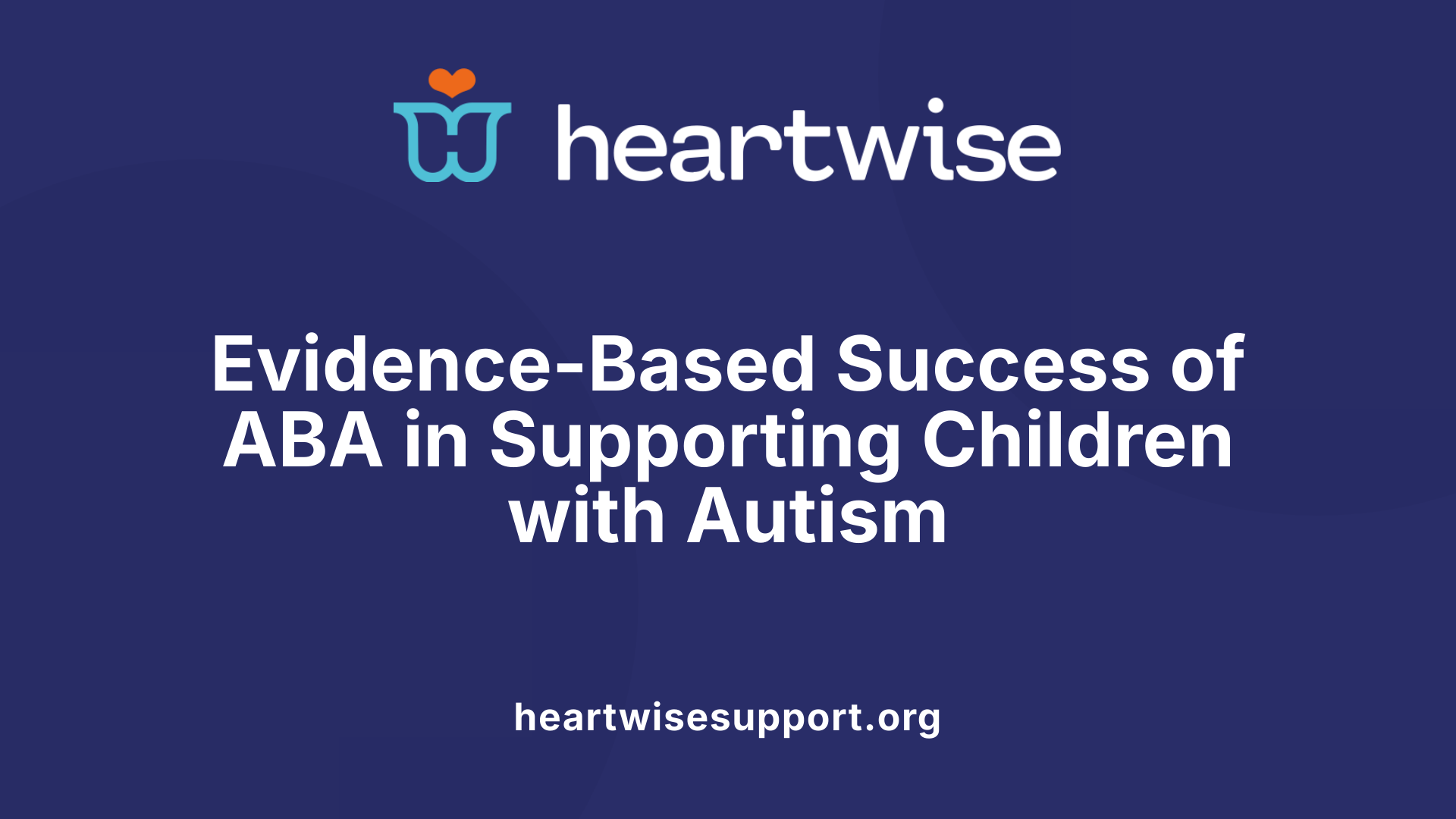Understanding the Role of ABA in Early Childhood Support
Applied Behavior Analysis (ABA) is a scientific approach to understanding and altering behavior, extensively used in early intervention to support children with developmental delays and autism spectrum disorder (ASD). As a well-established, evidence-based therapy, ABA focuses on systematic assessment, targeted interventions, and data-driven progress monitoring, aiming to foster meaningful skills and reduce maladaptive behaviors in young children. Its principles are rooted in the science of learning and behavior, emphasizing positive reinforcement and environmental modifications that promote developmental gains across various functional domains.
Definition and Application of ABA in Early Childhood

What is applied behavior analysis (ABA) and how is it used in early childhood intervention?
Applied Behavior Analysis (ABA) is a scientific approach to understanding and influencing behavior. It is rooted in research and focuses on how behavior works, how it is affected by the environment, and how learning takes place. ABA aims to help children develop useful skills while reducing harmful or disruptive behaviors.
In early childhood intervention, ABA plays a vital role, especially for children suspected of having or at risk for developmental delays or autism spectrum disorder (ASD). It is used to teach vital skills such as communication, social interaction, and daily living tasks. Therapists tailor interventions to each child's unique needs, often involving intensive, one-on-one sessions.
These sessions typically occur several hours per week, focusing on behavioral strategies like positive reinforcement and systematic analysis of antecedents and consequences — often summarized as the A-B-C model. Through continuous data collection, practitioners modify programs to ensure optimal progress.
ABA practices are incorporated into early childhood programs by trained behavior analysts, including Board Certified Behavior Analysts (BCBAs), who develop and supervise personalized intervention plans. The goal is to foster independence, improve social skills, and enhance the child's overall quality of life.
Overall, ABA in early childhood aims to be a comprehensive, evidence-based tool for promoting meaningful developmental gains, helping children reach their full potential in various environments, including home, school, and community settings.
Core Techniques and Methodologies in ABA

What are the key components and techniques used in ABA therapy for young children?
Applied Behavior Analysis (ABA) employs a variety of evidence-based strategies tailored to the needs of each child. Central to ABA is the development of individualized treatment plans, which are crafted through comprehensive assessments and functional behavior analyses.
The fundamental techniques used in ABA therapy include positive reinforcement, where desired behaviors are rewarded to encourage their recurrence. Prompting and fading are techniques that help children learn new skills by providing cues and gradually reducing assistance.
Task analysis breaks down complex skills into manageable steps, making learning more accessible. Modeling, both by therapists and through video or visual aids, demonstrates desired behaviors in a clear, watch-and-imitate manner.
Behavior chaining involves linking simple behaviors into more complex sequences, supporting skills like self-care routines or social interactions. Natural environment teaching leverages everyday settings to promote skills in real-life contexts, enhancing generalization.
Data collection plays a vital role in tracking progress. ABA practitioners analyze data through methods like ABC (antecedent-behavior-consequence) analysis, which helps identify triggers and reinforcement patterns.
Interventions are personalized based on ongoing data, ensuring relevance and effectiveness. Strategies such as visual supports, script fading, and behavior contracts contribute to reducing problematic behaviors while fostering new, functional skills.
Overall, ABA’s approach combines scientific research with practical techniques, aiming to enhance communication, social skills, and adaptive behavior in young children. Its focus on data-driven, individualized care underpins successful intervention outcomes for children with developmental challenges.
Scientific Evidence and Effectiveness of ABA for Children with Autism

What evidence supports the effectiveness of ABA therapy for children with autism?
Research since the 1960s has consistently demonstrated that Applied Behavior Analysis (ABA) is a scientifically validated treatment for autism spectrum disorder (ASD). Numerous studies and meta-analyses have shown that early, intensive ABA interventions can significantly improve communication, social interactions, and adaptive behaviors in children with ASD.
One of the most compelling findings is that starting ABA therapy at a young age—particularly before age five—yields better developmental outcomes. Children receiving tailored, data-driven interventions typically show progress in language skills, social engagement, and daily living activities.
The application of positive reinforcement, systematic data collection, and intervention in natural settings support the child's ability to generalize learned skills. Furthermore, the consistency of treatment across home, school, and community environments ensures lasting improvements.
Overall, ABA's evidence base, gradually built over decades, affirms its role as an essential, effective approach in supporting children with autism. Its adaptability and research-guided procedures continue to promote significant developmental gains, enriching the quality of life for many children and their families.
Assessment, Evaluation, and Program Planning
 Understanding how to effectively implement Applied Behavior Analysis (ABA) requires knowledge of the assessment and planning processes involved. Central to these processes are functional behavior assessments (FBAs), preference testing, and the development of individualized behavior intervention plans (BIPs).
Understanding how to effectively implement Applied Behavior Analysis (ABA) requires knowledge of the assessment and planning processes involved. Central to these processes are functional behavior assessments (FBAs), preference testing, and the development of individualized behavior intervention plans (BIPs).
Functional behavior assessments are systematic procedures used to identify the purpose or function behind a child’s behaviors. By analyzing antecedents, behaviors, and consequences—often summarized as A-B-C data—behavior analysts can determine why a behavior occurs. Preference testing complements FBAs by identifying a child’s motivating reinforcers, such as toys, activities, or sensory inputs, which can be used to strengthen desired behaviors.
Once assessments are complete, tailored intervention plans are created. These plans specify strategies to encourage positive behaviors while reducing maladaptive ones. Techniques may include positive reinforcement, environmental modifications, and skill-building activities. The plan outlines clear, measurable goals aligned with the child's developmental needs and the data collection methods to monitor progress.
Data collection and ongoing progress monitoring are vital components of ABA treatment. Continuous tracking of behavior frequency, duration, and intensity helps determine whether interventions are effective. If progress stalls, data analysis guides modifications to strategies. This cycle of assessment, implementation, and adjustment ensures that interventions remain responsive and person-centered.
In practice, effective ABA application progresses through four main stages: learning new skills (skill acquisition), achieving proficiency (fluency), applying skills across various settings (generalization), and sustaining these behaviors over time (maintenance). Strategies such as Discrete Trial Training (DTT) facilitate initial skill learning, while fading prompts helps attain fluency. Natural Environment Training (NET) supports generalization by teaching skills in real-life contexts.
To succeed, interventions must follow key principles: consistency across caregivers and settings, use of positive reinforcement, data-driven decision-making, and naturalistic teaching. Collaboration among trained professionals and patience from families are essential. This structured approach ensures that each child's development progresses meaningfully, with skills that are durable and adaptable to everyday life.
For an in-depth understanding of evaluation procedures and intervention planning within ABA, exploring current literature and expert guidelines is recommended. These resources provide detailed protocols and case studies that illustrate best practices in assessment and program development.
Family and Community Involvement
Parent coaching and training are central to effective early intervention using ABA principles. When families are actively involved, they can reinforce positive behaviors and skills in everyday routines, which supports generalization and maintenance of progress. Families often receive training from behavioral therapists on strategies such as positive reinforcement, functional communication training, and managing sensory sensitivities. This collaborative approach empowers caregivers to create consistent, supportive environments at home.
Family advocacy and resource navigation are also crucial components. Advocates assist families in accessing external services, understanding treatment options, and securing necessary funding or insurance coverage. Connecting families with community resources, support groups, and educational programs helps foster a network of support essential for sustained development.
Building a supportive environment for skill generalization involves creating settings that promote learning across home, preschool, and community. This can include modifying the environment to reduce sensory overload, using visual supports, and establishing routines that incorporate ABA strategies. Such practices help children apply new skills in various contexts, promoting independence and social integration.
How can parents and caregivers find, evaluate, and select appropriate ABA providers for early childhood support?
Parents and caregivers can identify suitable ABA providers by seeking referrals from medical professionals, schools, or trusted community organizations. It’s important to review the credentials of providers, such as certifications from the Behavior Analyst Certification Board like BCBA (Board Certified Behavior Analyst) and RBT (Registered Behavior Technician). When evaluating providers, consider their experience with young children, treatment philosophy, and their ability to develop individualized, evidence-based programs.
Parents should verify insurance coverage, inquire about the provider’s supervision and training processes, and ask how progress is monitored and reported. Visiting clinics or therapy sessions, asking questions about the approach, and seeking reviews or testimonials can help gauge effectiveness and compatibility with the child's needs. The goal is to choose a provider whose methods align with ABA principles, prioritizes family involvement, and maintains flexibility to adapt interventions as the child progresses.
More information about choosing and evaluating ABA providers for young children
| Evaluation Criteria | Questions to Ask | Additional Tips |
|---|---|---|
| Credentials and Certifications | Are the providers certified as BCBA or RBT? | Certifications ensure trained, qualified personnel. |
| Experience with young children | Do they have specific experience with early childhood populations? | Experience leads to better understanding of developmental stages. |
| Treatment approach | Do they follow evidence-based ABA practices? | Avoid providers using unproven or inconsistent methods. |
| Individualized planning | How are programs tailored to my child's needs? | Effective programs are personalized. |
| Family involvement | Will I be trained to support the therapy at home? | Continuous family involvement enhances outcomes. |
| Progress monitoring | How is progress tracked and communicated? | Regular updates foster transparency and adjustments. |
| Safety and environment | What safety standards are followed? | Safe, sensory-friendly settings are essential. |
Choosing the right ABA provider is a significant step toward supporting a child's development. With thorough evaluation, families can find professionals who deliver effective, compassionate care tailored to their child's unique needs.
Integrating ABA into Broader Early Education Practices
How is ABA incorporated into blended practices and curricula?
Applied Behavior Analysis (ABA) principles are increasingly integrated into early childhood education through blended practices. This approach combines ABA with other teaching strategies like authentic assessment and systematic instruction. By collecting data, conducting functional behavior assessments, and applying tailored interventions, educators can address individual children's needs effectively. The curriculum framework supports this by focusing on assessment, scope and sequence, activities, and progress monitoring, all of which can be enhanced with ABA techniques.
How does ABA promote authentic assessment and responsive interactions?
ABA emphasizes authentic assessment methods that observe children in natural settings to understand their behaviors and learning styles. Responsive interactions foster positive learning environments, where teachers respond appropriately to children's cues, helping to build communicative and social skills. Techniques such as preference testing and functional behavior assessments allow educators and behavior analysts to analyze behaviors and develop personalized intervention plans.
How can early childhood environments be made more engaging and inclusive?
Creating engaging, inclusive environments involves designing spaces that support sensory needs and promote participation for all children. ABA principles guide the development of such settings by encouraging systematic instruction, environmental modifications, and sensory-friendly strategies. These environments help children develop essential skills, reduce problematic behaviors, and foster social engagement.
| Aspect | Implementation Strategies | Details |
|---|---|---|
| Authentic Assessment | Natural observation, data collection | Gathers real-time information about child behavior and progress |
| Responsive Interaction | Teacher responsiveness, individualized responses | Builds trust, encourages social and communication skills |
| Engaging Environments | Sensory-friendly spaces, adaptable materials | Supports diverse needs and enhances participation |
| Instructional Methods | Systematic instruction, preference testing | Ensures tailored, effective learning experiences |
Limitations, Cost-Effectiveness, and Future Directions of ABA
What are the limitations and considerations regarding the cost-effectiveness of ABA interventions?
While early intensive ABA programs have demonstrated positive outcomes, such as improvements in adaptive behavior and IQ scores, their cost-effectiveness remains a concern. Delivering 20-50 hours of therapy weekly over several years requires substantial resources, which can be a barrier for many families and service providers.
Research indicates that although these interventions are effective in fostering skill development, the long-term financial and practical sustainability is uncertain. Limited follow-up data on outcomes like autism severity reduction or educational placement further complicate cost evaluations.
Evidence suggests that unless long-term benefits, such as sustained independence or improved educational integration, are clearly demonstrated, the economic justification for such intensive programs is challenging. In response, ongoing research aims to modify ABA methods to be more efficient and less costly, striving to make high-quality intervention accessible to a broader population.
What is the current state of research and what future developments might enhance ABA?
Future progress in ABA centers on refining intervention strategies to optimize outcomes while reducing costs. Innovations include developing less resource-intensive models, integrating technology for remote coaching, and personalizing treatment plans based on individual needs.
Long-term studies are vital to understanding the enduring impacts of ABA, including effects on autism symptoms, social skills, and academic success. As evidence accumulates, clinicians and policymakers hope to establish more sustainable, scalable approaches that maintain high effectiveness.
In summary, while ABA remains a highly evidence-based practice with proven benefits, addressing its cost-effectiveness and ensuring long-term positive impacts are ongoing priorities. Future developments are expected to improve both the quality and accessibility of ABA services.
Conclusion: Embracing Science for Better Child Outcomes
Applied Behavior Analysis (ABA) plays a vital role in early childhood intervention by systematically improving developmental skills and reducing problematic behaviors in young children, especially those at risk for or diagnosed with autism spectrum disorder. Rooted in scientific research, ABA strategies involve data-driven assessments, tailored intervention plans, and reinforcement techniques designed to support positive growth.
Collaboration between parents, educators, and behavior analysts is fundamental to maximizing the benefits of ABA. Parent education and involvement are emphasized parts of early intervention programs, equipping families with effective strategies to support their child's development at home. This team approach ensures consistency across environments, fostering meaningful progress.
Looking ahead, the future of ABA in early childhood holds promising innovations. Advancements may include integrating technology for more precise data collection, developing less intensive yet equally effective intervention models, and expanding program accessibility. Continued research and collaboration will help refine practices and enhance outcomes for children, ensuring that behavioral science remains a cornerstone of early developmental support.
Final Thoughts on ABA in Early Childhood Support
Applied Behavior Analysis stands as a cornerstone of evidence-based early intervention, offering scientifically validated strategies that support young children’s development across vital domains. Its systematic approach, emphasizing personalized intervention, data collection, and positive reinforcement, helps improve skills and reduce challenging behaviors, fostering increased independence and quality of life. Collaboration among families, educators, and trained professionals is essential to maximize benefits and ensure interventions are tailored to each child’s unique needs. As research advances and practices become more refined and accessible, ABA’s role in early childhood support is poised to expand, promising brighter developmental pathways for children with autism and other developmental delays.
References
- Applied Behavior Analysis in Early Childhood Education
- Early Intervention Services for Children with Autism
- ABA Early Intervention Program - Seattle Children's Hospital
- Interventions based on early intensive applied behaviour analysis ...
- Applied Behavior Analysis (ABA) | Autism Speaks
- ABA Therapy vs. Early Intervention: What's Best for Your Child?
- 7 Essential Rules of ABA Therapy You Should Know |
- Is Your Child the Right Age for ABA Therapy? Find Out Now!
- Understanding the 4 Stages of Learning in ABA
- What Are the 5 Steps to Understanding ABA? Essential Insights











